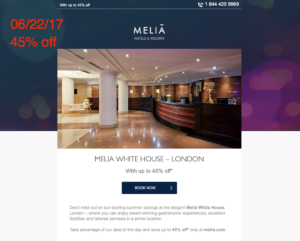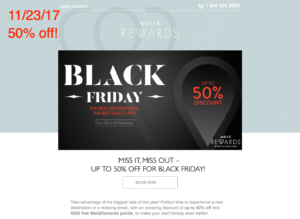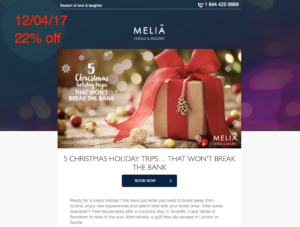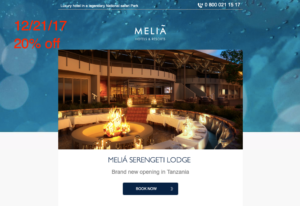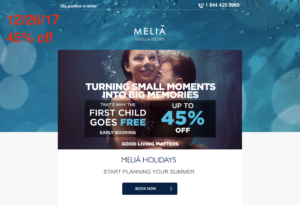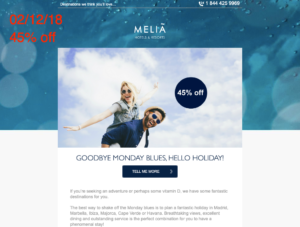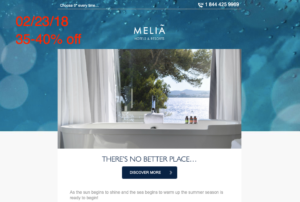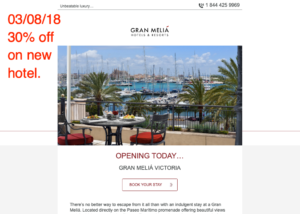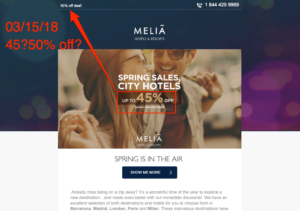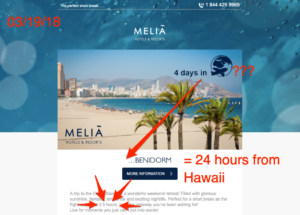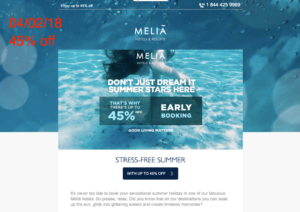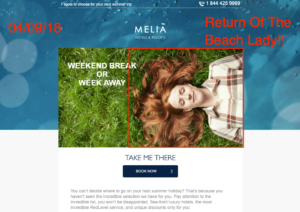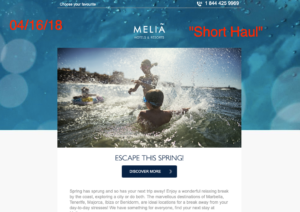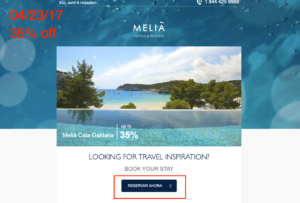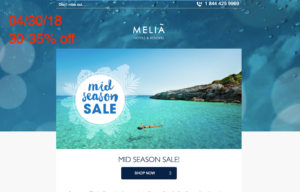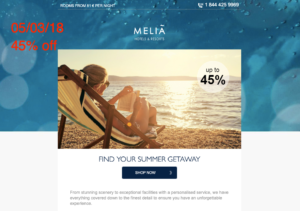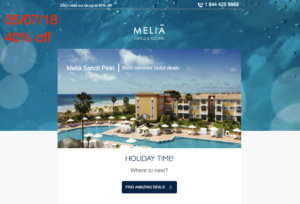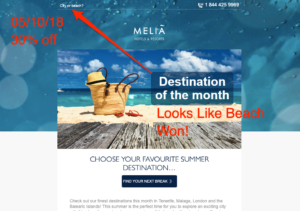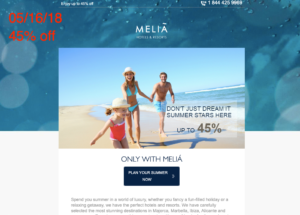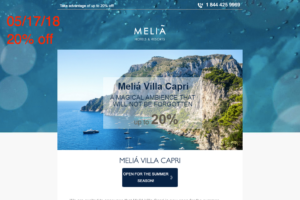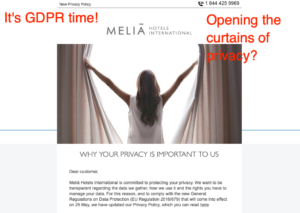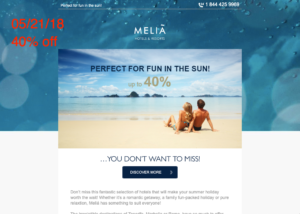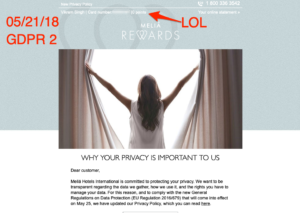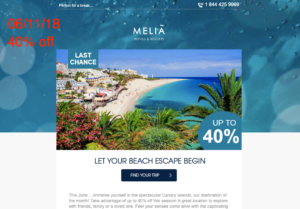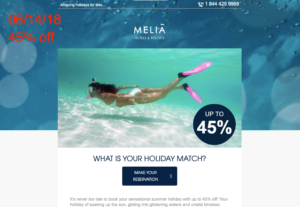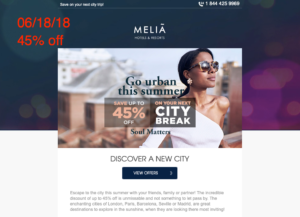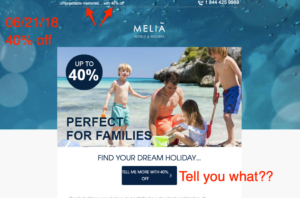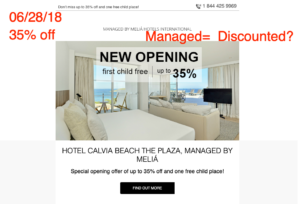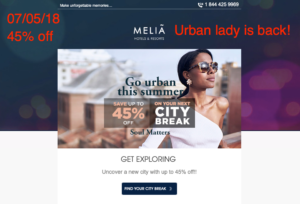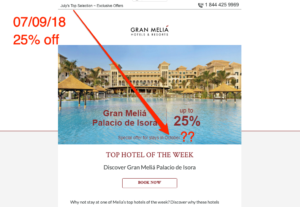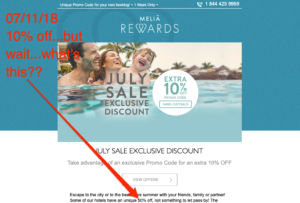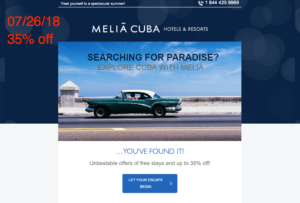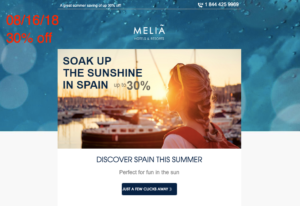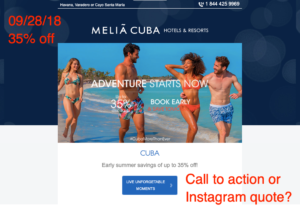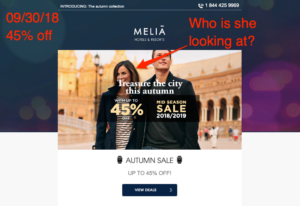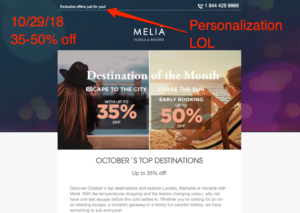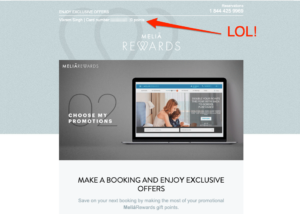On January 20, 2017, I booked a hotel in Seville, Spain. That is also the day that Meliá Hotels & Resorts got my email address. The rest, as they say, is history.
For those of you who are not familiar with EU-based hotel companies: Meliá Hotels International is a Spanish hotel chain also known by its former name of Sol Meliá. They have 374 hotels in 40 countries on four continents. They are not a big household name in the US, but they got some attention back in 2010 when they sold their “Tryp” brand to Wyndham Hotels. I made several groovy jokes back then about Wyndham “Trypping,” which thankfully nobody remembers. Moving on.
So why am I taking you all the way back to 2017? Since my initial interaction with Meliá Hotels, I have received 2-3 emails from them every month. After deleting some of the earlier ones, I was almost ready to “Unsubscribe.” Then I had an epiphany: how about I stay on the list and see how this multi-billion dollar hotel company handles its Customer Relationship Management (CRM), and in particular its email marketing campaigns.
What started almost two years ago is now ready to be shared.
Buzzwords, They Keep on Buzzing
There have been over a dozen articles (plus a couple of white papers) telling us how software is transforming the hotel CRM landscape. There is more talk about how “personalization” is changing everything. However, my two-year collection of emails from a well-established hotel brand sheds a very different light on how things are in the real world.
There are over a dozen CRM vendors who will sell you their software….I don’t think this is a software issue. The biggest CRM challenge for hotels is hiring the right people. Lack of talent is a much bigger threat to the hotel industry than our world-renowned outdated technology.
Let’s Take a Trip Down Memory Lane
A couple of things to keep in mind as we take this journey together:
- Meliá Hotels is just an example I am using for this post. I am not singling them out as an outlier. Before you high five your marketing team, please know that there are 5-8 other hotel brands (big box and independently owned) who have sent me a similar pattern of emails.
- I have not included every email ever sent to me. Some were deleted while I logged a quarter million miles of flying last year.
- This year I published the Ultimate Guide To Hotel Email Marketing. If you think you may need help, read my guide to start sending better emails.
I stayed at the Gran Meliá Colon Hotel in Seville in April 2017. After the usual follow-up emails about my stay and 2-3 emails about leaving them a review with TripAdvisor (which I never do), a barrage of discount emails started hitting my inbox. In June 2017, I started to document some of them.
Let’s roll.
June 2017
The first email I saved offered 45% off their hotel in London, Wow, quite a deal, right? Pay attention to the “45% off,” as it will make a comeback…again and again…like Jason Voorhees.
July 2017
In July, the discount dropped…but not for long.
August 2017
August opened strong with deals to Milan…40% off!
Dropped by 5% mid August. Dang, should have dropped everything and gone to Milan from Hawaii 4 days ago! It’s not that far, is it?
Three days later, the offer is limited to only one hotel! I still have not been south of Seville. Maybe I should quit what I’m doing and head to the Southern shores? But what about the North/Atlantic part of Spain? I want to go there too. Will I get 35% off ever again? What about the 45% deal? Is it ever happening for me again?
September 2017
Dear diary, the 40% deal is back!! Wait a minute…it’s for booking next summer!? What if I don’t get time off? Unless I am working in Europe, there is no guarantee of a summer break. In the US, there is no guarantee of ANY break. 40% off is too good to pass up, but I don’t know where I will be in the summer of 2018.
Are you kidding me? 22%!? Guys, I do not get out of bed for less than 40%. You have done 40% for me before. Why are you giving me only 22% off now? Are you guys mad at me for not booking last time?
October 2017
Sweet relief! The 40% deal is back! But wait…I need to go urban this autumn? I can’t go urban this autumn! I only go “urban” in the winters!
November 2017
OMG! I cannot believe this! 50% off! How is this happening? How are they going to make any money? But wait…the email mentioned “This is only the beginning.” What does that even mean? More 50% off emails, or will I be getting even bigger discounts!? This is getting out of hand, but I really cannot travel right now so…I shall pass on this miracle. Alas, it might never happen again in my lifetime.
It’s another miracle! But this miracle actually ends on Sunday! Black Friday is not just about brawls at the local Walmart anymore. It is now about deep discounts. Sounds like I will never pay retail again for my hotel room…thank you! I feel like I am living in the golden age of hotel discounting. How neat is that!
OMG! Three miracles in one month! This is all that’s playing in my mind right now: “We are not worthy!” I guess Cyber Monday is no longer about buying bulk paper towels. You can now get 50% off for booking a room you otherwise would have gotten at full rate. There is a lesson in here somewhere.
December 2017
22% off is for the birds! 40-50% off and then we can talk. “Season of love and laughter.” Please. If you really cared, you would offer a better deal. From 50% to all the way down to 22%…now I am sad.
Are you kidding me? 20% off. Let me put on some sad music to go with this deal.
Oh, look who’s back! 45% is nice…but what’s with the lady trying to drown the kid? Love the “say goodbye to winter” tagline. If only it was so simple. Besides, I like winter in Hawaii!
30%? No thanks. “Am I well travelled?” Does logging over a million miles in the air count?
January 2018
LOL! “Head to London in February” = Someone who has never been to London in February. Hard pass.
Oh look, the underwater lady and kid are back! 45% off to book for summer. Again, no idea where I will be, but thanks for asking.
February 2018
“Jet off to somewhere soon.” Guys, 40% off is great. But remember, we don’t do time off in US. Hope the lady has sunscreen on.
45% off is good. But…”Goodbye Monday Blues”? I love Mondays! What’s wrong with Monday?
The underwater lady is back! I really hope that kid is all right.
So glad I did not book 4 days ago @45% off! 50% discounts are back! “Book now or regret it later.” Wait, are you threatening me?
“There is no better place.” Apparently that place is also secret enough to not be above the fold in the email design. Life is full of surprises, I guess.
March 2018
Nothing inspires confidence in a new hotel like a 30% off deal on Day One.
In the era of “fake news,” your tagline % better match the actual offer.
Four days in…where? I would love to hop there in 2.5 hours. When I checked into the hotel, they copied my ID, passport, credit card. Sir, I am not 2.5 hours from anything!
April 2018
Oh look! It’s the return of 45% off Summer.
Three days later: 20%? No, thank you. Hey, what’s the mysterious black stuff on the beach outlining Best Offers? (Cue in X-Files theme.)
Beach lady makes a comeback! This time on 100% green grass. Did she like her beach vacation? We will never know.
“Short Haul” in body copy of email sent to the other end of the world. LOL.
“Reservar Ahora.” English email, Spanish call to action. Can’t lose?
“Mid Season Sale”…but that lady is floating in the water. Will she catch a cold? Also, 30-35%…I’m more of a 45% and above kind of guy.
May 2018
Back to 45%, now we’re talking.
Four days later, down to 40%.
Beach won this round.
Back to 45% 6 days later.
20%…how about not.
It’s GDPR season! Also, is she opening or closing the curtain on my privacy?
40%…hey, it’s better than the 20% off from last week.
GDPR curtain lady returns! Also, check out my points balance!
20%… nope.
June 2018
Cool kid with shades giving 45% off.
Oh no, I lost 5% discount in 2 days! This one says it will hold for 10 days only! What if I am stuck in 20% discount land after that?
Last chance? Are you sure? I will never get a discount again? Oh no!
Oh c’mon! I thought 40% was valid for 10 days ONLY! Here you are seven days later giving me 45% off! I thought we were friends.
Going urban? Sure, like Urban Outfitters? Oh hello, 45% off. Nice to see you again.
“Unforgettable memories…with 40% off” is a hilarious snippet. But wait…there’s more. “Tell Me More With 40% Off” is a hilarious call to action! How do they do it?
Nothing will warm the heart of a hotel ownership group like having their management brand kick off a new opening with 35% off.
Cool kid with shades giving 45% off is back!
July must be about comebacks. Urban lady feels like a friend now.
July offers…but for October. Let me stop everything and figure out this email. Also, only 25% off?
10% deal? Do you even know who I am? I have not gone below 20% with you! Also, 50% off in the copy of the email. What game are we playing here?
I am still mad about the 10% email. But ok, glad to see we are back to 45%.
45% off…keep em’ coming, baby!
Searching for paradise? Dude, I live in Hawaii. Have you even checked my profile/analytics? Oh, never mind.
Wishing on a star that the next email will be 45% off.
Yes! My wish came true. 45% off email is back.
I get sun here in Hawaii. In Spain, I soak up some of the world’s best food. Didn’t I do so many food-focused things in Seville? Do you remember anything about me?
Escape from what? I am not trapped anywhere. Do you think I am? Why?
35%. Meh.
35%. Meh.
Did someone mix up their Instagram motivational quote with their call to action? Also, they spelled unforgettable wrong. Also, 35%. Meh.
45%, yeah! Wait, who is she looking at?
“Exclusive Offers Just For You.” LOL!
Last one. Check out my amazing point balance.
CRM Is Not An Acronym for Email Marketing
Somewhere along the way, hotel CRM has evolved into just sending emails to guests. The typical five-step email cycle breaks down as follows:
1. Booking confirmation email
2. Reminder email
3. Check-out email
4. Request to review the property on TripAdvisor (2-3 emails)
5. Discount emails for the remainder of your life
Break the cycle. You have too much information about your guest for you not to care about segmenting. Break down your lists by geography, interests, age, and then stay in touch for more than just discounts. Hotels all over the world have scanned or photocopied my passport and driver’s license. That level of personal information is only available to the TSA (Department of Homeland Security) and border control agencies worldwide. And yes, a small hotel in Kyoto. Think about it.
Three Step Plan for Improving Your Hotel’s CRM
Step 1: Designate CRM ownership. Select a person to lead your CRM efforts and strategy. Your customer database is something you need to own and maintain over time. Your database should not be passed around like a basketball, available to any department that wants to take a “shot” at making the basket.
It is not about software, it is about who is keeping an eye on things. Any customer contacts should get a final stamp of approval from a central person who is keeping an eye on CRM database quality and ongoing business analytics.
Step 2: Check yourself before you wreck yourself. Two parties have traditionally misused the hotel email database.
- Sales and marketing. Avoid sending a promo about something that not everyone would be interested in (eg, local restaurant/bar promos that get blasted out to everyone in your database, including guests who never used it and live over 3000 miles away).
- Revenue management. You guys are great, but please stop using your email database like an ATM machine. Every time the revenue numbers slack off a bit, you can’t just pull the lever on an “exciting 45% off” email and wait for the reservations to trickle in. Oh, this also answers another question I get a lot. “Why are our campaigns not performing like they did last year?”
Step 3: Segment or go home. Your hotel customer database is not going to stay fit and fine forever. It is not Hisako Manda. In addition to performing ongoing maintenance, you also need segmentation. One big list should make way for smaller segmented lists. Examples include:
- Geographic location
- Clicks (0, 1, or more?)
- Frequency of use (checked in more than once?)
- Replies
Conclusion
Somewhere along the way, hotel CRM became synonymous with email marketing. This is really unfortunate because, unlike other industries, hotels sit on a mountain of personal data. Generic outreach chips away at any hope of building a relationship with your guests. There is a ton of speculation in the marketplace about who truly “owns” your guest. The truth is that nobody owns your guest, but you sure can make an effort to reach out and be their friend. Remember, nobody makes friends and builds relationships just by offering discounts. You have to share value to see your revenue numbers grow.


